St Augustine, Broxbourne, Hertfordshire - Monuments
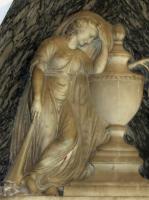
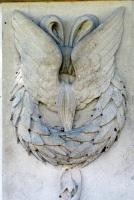
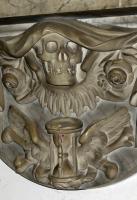
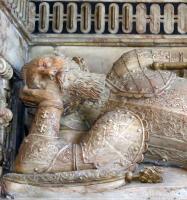
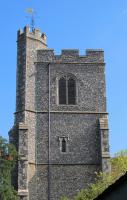
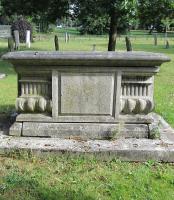
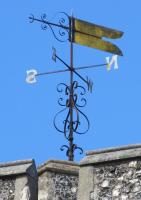

The approach to St Augustine Broxbourne is straight towards the noble battlemented tower,
faced with flint, with its corner turret and several supporting buttresses. From the churchyard,
we see it is rather long and low, with a central tile roof over the nave, and crenellated aisles,
and with a chapel at the rear of stone, with crocketed pinnacles it is the Saye Chapel of 1522, and beneath
the parapet is an inscription to 'Pray fot eh welfayr of Sir Wylyam Sae, knygt wych fodyd yis
Chapel in honor a ye Trenete the yere of our Lord God 1522'.
The whole Church was built in the 15th and 16th Centuries according to Pevsner, and is in the Perpendicular Gothic style. Nothing remains from
previous times, when the manor was in the possession of the Knights Templar. The interior of St Augustine is dark, atmospheric,
with its dark wooden ceiling, ligher wooden pews, and tall clustered pillared arches separating the nave
from the aisles. And all along the walls are an abundance of panel monuments,
and one grand one with reclining effigies.
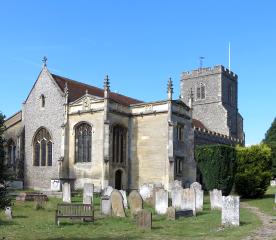
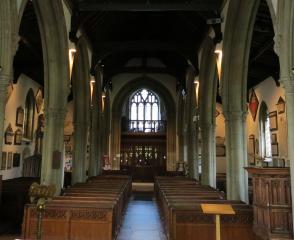
St Augustine Church, Broxbourne.
Monuments
We start with the monument to Sir Henry Cock and then look at the rest in date order.
Sir Henry Cock, d.1609. and his wife Ursula Cock, d.1611:
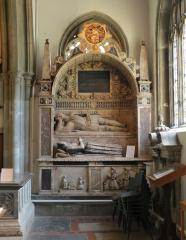
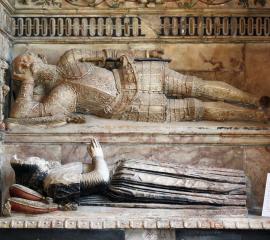
Monument to Sir Henry and Ursula Cock, early 17th Century.
A grand monument with two effigies. Previous generations had had husband and wife effigies
next to each other as if on a bed, but for a while the fashion was as here, to have the wife in front,
lying on her back, and the husband behind but raised up, and on his side, so giving a better view
to the spectator. They lie between blocky pillars supporting a grand arch, within which is the inscription
on a black panel, surrounded by a characteristic space-filling design of low relief carving,
including scrolls, flowers, a little skull and fruit. Above this, a pointed arch of the window,
blocked out by the coat of arms of Sir Henry, in a circle with strapwork, and to each side,
free-standing obelisks with ball feet and balls on top, evocative of the Egyptian cult of the afterlife.
On the lower front panel beneath Lady Ursula are their descendants apparently two being the daughters,
and the others the grandchildren, according to a note within the Church (oddly, older references mention
sons as well as daughters).
These small kneeling figures are on the right, two grown females with large ruffs and
astonishing headpieces, and four miniature offspring, replicas of the adults.
All bar the rear larger figure had died by the time this monument was made, as shown by the skulls
they carry, and there is enough of a broken remnant in the praying hands of that last survivor
that we must wonder if she too had not once held a skull. On the left hand side are a boy and a girl,
the boy with his own faldstool (prayer desk) bearing a book and covered with a hanging drape.
Both of them have skulls too, so it seems that almost the whole family died out at this time. (More on skulls
on this page).
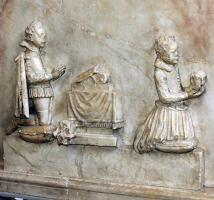
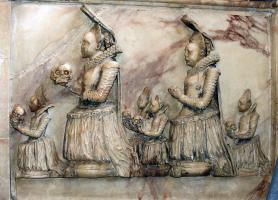
Kneeling figures of the Cock children and grandchildren.
Back to the main figures of Sir Henry and Lady Ursula. Sir Henry is in beautifully inscribed plate armour,
highly drapery, and the figure, though partly reclining, and with much naturalism to the face, legs and hands,
shows him in a stiff pose, especially the upper arm and the positioning of the calves. Lady Ursula,
lying with her hands raised in prayer, her bonneted head resting on two tasselled cushions, is even stiffer,
with the folds of her skirts hanging almost horizontally (i.e. with the line of the body) and no discernible gravity.
Regardless, an excellent and noble work of sculpture.
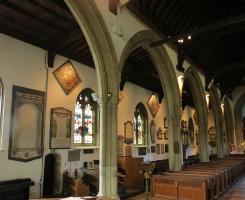
Massed panels along the aisle wall.
Monuments, 16th and 17th Centuries:
- Sir William Say [Saye], d.1529. An altar tomb with a Tudor canopy above. There used to be brasses, many of them,
but all are gone and only the indents remain (picture below right). The canopy is fine, with octagonal pillars, and with
repeating quatrefoils and crocketing on the upper level, which is divided with a further pair of octagonal
divides to make something of a six-poster. The underside of this canopy is finely carved with trefoils and pendants,
like the ceiling of a miniature Gothic cathedral.
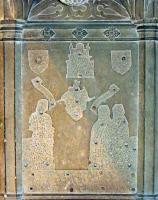
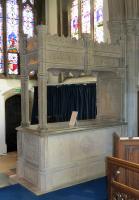
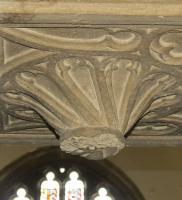
Sir William Saye, d.1529 - altar tomb with canopy.
- Sir Richard Skettington, d.1647, with a lengthy inscription on a black panel.
To the sides, black-shafted pilasters (flat pillars), upper and lower shelf, and at the top, a curved, open pediment
with damaged shield of arms, coloured, within it (picture below left). It is unlikely that this particular block came from this monument,
as the proportions are wrong and the colour of the marble different. At the base of the monument,
a small, broad panel with carved Acanthus leaves and a bells-shaped terminus.
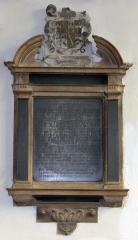
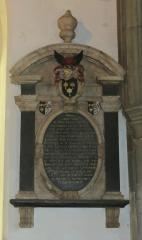 Mid-17th Century Classical tablets - black panels, side pilasters, curved pediments.
Mid-17th Century Classical tablets - black panels, side pilasters, curved pediments.
- William Gamble alias Bowyear, d.1658, late of Laytonstone in the County of Essex, Esquire,
who married Katherine Daughter of Sir Marmaduke Rawdon in the County of Hertford Knigh[t] and of Dame Elizabeth
his wife, and by her had Issue eight Sonnes and five Daughters... A Classical mural monument of pinkish alabaster
and black marble (picture above right). The inscription, on a black oval panel, is within a rectangular frame flanked
by black-shafted pilasters; painted shields of arms above left and right, and on the entablature above,
a larger shield of arms with knight s helm, mantling etc, rising into the curved, open pediment,
which bears on top a strange urn. At the base, a thin shelf supported on moulded brackets.
Such pieces were to last through till about the 1690s, before being replaced by a more purely Classical type.
- Jacob Monson, d.1688, and John Monson, double panel, with two ovals, and pillars on either side
and between, upper entablature and a curly pediment, broken at the top to enclose a large free-standing pot or urn
with gadrooned (corrugated) shoulder. A small painted cartouche of arms is below the pot.
This piece is attributed to the eminent William Stanton, according to Gunnis, the monumental historian.
Monuments of the 18th Century:
- A grand Classical panel which I could not read. The inscription is on a black backing,
surrounded by a beige, darkened marble frame, with free-standing pillars to the sides, an upper entablature,
and on top, a coat of arms resting uneasily enough that presumably it is but the survival of some superstructure,
perhaps a pediment; the risers over the pillars appear too to have had something upon them.
At the base, an apron with a carved drapery hanging from two knots, with some semi-circular central piece
that likely once held some protruding accoutrement. Although black inscribed panels are occasionally found much later,
they are most characteristic of the 17th Century.
- George Jacob Williams, William Peere Williams, and his wife Anne, an undated panel
with an obelisk of dark marble above, on which is a fine carving of an urn in high relief, with shield of arms,
and fluting (picture lower down, left).
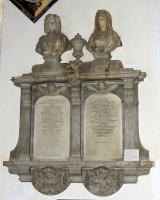
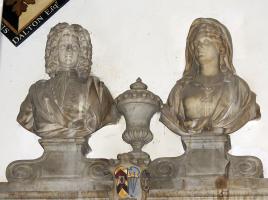
Sir William and Lady Laetitia Monson.
- Sir William Monson, Baronet of Burton, Lincs, d.1726, and his wife, Lady Laetitia Monson, d.1734,
herself a daughter of Baron Boulett. Both of them have eulogies, noting his offices and her charitable works,
including a surviving almshouse in the High Road. The two panels, arched at the top, are separated by a pilaster;
identical pilasters are to the sides, and at the top of each arch is a carved winged cherub head.
Above, a shelf, central painted cartouche of arms, and busts of the couple, with a small funereal urn between them - see picture above,
you will want to click to enlarge.
Sir William shows a high forehead under his full periwig, his face somewhat weakened by a plump, rounded chin,
not something that ever seems to have disturbed the portrait sculptor of the early 18th Century, where showing signs
of good living was a compliment. He wears a kerchief wound around his neck as a collar,
and has an embroidered shirt under a swathe of drapery. His face is perhaps early middle age,
while Lady Laetitia is young, handsome in an almost Greek sense, were it not for that rounded chin again,
long, wavy hair down across one shoulder, head turned towards her husband, long neck smooth and columnar.
She has a hood of light drapery, and outer drapery similar to her husband, with a light garment underneath,
held together by a clasp and embroidered along the edges. Good sculpture of the period. At the base of the monument,
under each panel, is a tasteful group of memento mori, consisting for each a winged skull, with drapery
somewhat over it and hanging at the sides, held by cockle shells, and with roses, nicely carved, over the wings.
On Sir William s side we also have crossed bones behind a pair of wings and an hourglass
another symbol of time passing and mortality and on Lady Laetitia s side are the crossed pick and shovel
of the gravedigger, tied together with a tasselled ribbon.
- William Peere Williams MP, d.1736, and his wife Anna Williams, d.1729?.
A large, baroque monument (picture below right). The inscribed panel has a curved top, on which sit longe a pair of cherubs
with a central funereal urn; this is in front of an inscribed circle. Above, a raised, broken pediment.
At the base, an apron with cartouche of arms, painted, and heavy fluted side brackets.
Flamboyant, and made in several different lined marbles. According to Pevsner, it is by a certain R. Bowles,
perhaps the Richard Bowles who made the font for Glynde Church, Sussex.
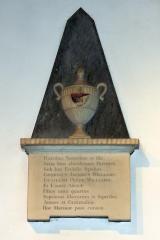
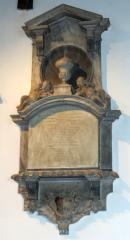 Williams family: Obelisk and Baroque panel.
Williams family: Obelisk and Baroque panel.
- William Hall, d.1762, and, added later, his wife Catherine Hall, d.1767,
oval panel with an upper surround with carved leaves, and at the base, a winged cherub head, the wings
rising up to enfold the lower portion of the oval.
- Margaret (Williams) Lewin, d.1763, wife of the Rector, the Revd. Edmund Lewin, d.1771,
also commemorated. He was Rector of Westmill, Herts, and Stone, Kent, and Chancellor of Rochester.
White panel with an arch, black surround, upper shelf, also arched, and at the base, a shelf and apron,
with a painted shield of arms within a cartouche upon it. By the mason T. Plows of Hertford.
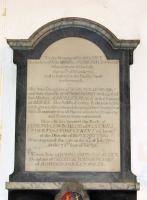
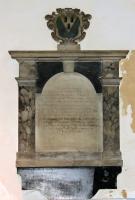 T. Plows of Hertford, mason. Panels to Lewin and Hutton.
T. Plows of Hertford, mason. Panels to Lewin and Hutton.
- Elizabeth (Halsey) Hutton, d.1769, of Senegal in the East Indies, Rachel Hutton Senior, d.1769,
Henrietta Senior, d.1766(?), and Elizabeth Baldrick Senior, d.1771. Panel with arch at the top and a keystone,
black spandrels (panels over the arch, pilasters of brecciated marble to the sides, upper shelf,
and above, a painted shield of arms within a cartouche. At the base, a second blocky shelf
and an apron of black marble cut to shape. Again signed by T. Plows of Hertford; a further example of his work may be seen in Hunsdon Church.
- John Perram, d.1772, Panel with arched top, surrounded by a dark marble frame,
with a curved shelf above and straight one below, and a curvy apron below.
- Thomas Jones, d.1792. A strange monument, the inscribed panel shaped like a tall jar,
with the thinnest of black borders. At the top is a shelf, and then the lid of the jar,
being a grey backing with a carved pot upon it. At the base, a smaller shelf with two supports
and a black central apron. Really very unusual. The inscription is interesting too he was
one of His Majesty s Judges of the Supreme Court of the Province of New York in North America ,
who suffered severe Hardships and great personal Injuries during the Troubles in America for his firm Attachment
to the British Constitution and ended up in Hoddesdon.
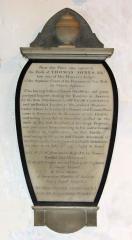
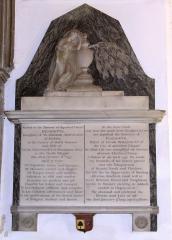 White on black panels of the 1790s: Judge Jones and Henrietta Bosqanquet.
White on black panels of the 1790s: Judge Jones and Henrietta Bosqanquet.
- Henrietta (Armytage) Bosanquet, d.1797, and her mother in law Elizabeth Bosanquet, d.1799,
commemorated on two halves of a broad panel. Above is a shelf on which is a plinth, with an alto relievo sculpture
of a mourning female resting against a pot, balanced on the other side by a dying tree.
The girl, swathed in figure-hugging drapery with a great loop over her head, is shown leaning an elbow
on the shoulder of the pot, legs crossed, giving a casualness that is characteristic of many monuments
at around this time. In her other hand she holds an upturned torch signifying the snuffing out of life.
Behind is a short, broad obelisk of black and tan marble, most striking, a reminder on this
otherwise monochrome monument of the predilection for coloured marbles which prevailed until about this time.
At the base of the monument is a thin shelf on two brackets, each bearing a carved flower,
and with a central painted shield of arms. But who was the sculptor?
Monuments of the 19th Century:
- Farington family, commencing with the Revd. William Farington, d.1767
and his wife Esther (Gilbody) Farington, and among numerous descendants listed through to the 1840s,
included Joseph Farington, d.1821, Royal Academician. Plain panel with curved top and painted shield of arms.
- William Christie, d.1811, and his wife Margaret Christie, d.1844, oval inscribed panel
encircled by a frame which is a snake swallowing its tail not an uncommon sign of renewal and rebirth,
if a touch pagan, but unusual in being the frame to the panel - see picture below left, but you need to click to enlarge. On a rectangular backing panel with an upper shelf.
On top of this sits a panel in the shape of a casket tomb, with outward slanting sides,
a lid with curled scrolls and little flowers and leaves carved in low relief, and lion feet.
It is to another William Christie, d.1816.
- Anne Jones, d.1817. An attractive white-on-black panel, the latter being cut as a broad pentagon,
with a casket-end upon it, the wide shelf filling the full breadth of the pentagon.
The casket rests on ball feet, and on top has an asymmetrically draped pot carved in high relief;
the proportions of the rounded, dumpy body of this fits well with the shape of the pentagon
- Susanna Hillock, d.1818, of the Island of St Vincent. Plain panel cut with feet,
with a thin black line border and a narrow shelf, on a black backing.
- Henrietta Williams, d.1819, wife of Admiral William Peere Williams of Hoddesdon.
An unusual monument, carved as a tall panel almost entirely covered with a hanging drape,
exposing the shield of arms at the top, with the inscription confined to a blocky base.
The black backing is carved with a pointed top, also unusual. Signed by Henry Westmacott of London,
one of the Westmacott dynasty of sculptors (see this page).
- Mary Lutyens, d.1819. White block with ball-feet, on a black backing with two small block supports.
See Theodosia Jones below.
- Francis Dalton, d.1819, casket end with ball-feet, upper shelf and pot, see picture below,
a copy of the Anne Jones monument noted above.
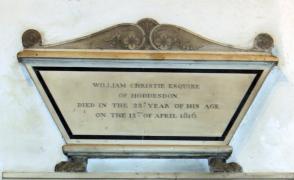
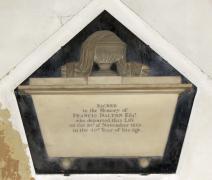
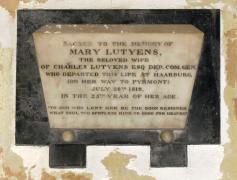
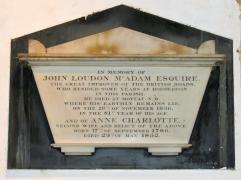
Early 19th Century casket ends: Christie, Dalton, Lutyens McAdam.
- Lutyens family panel, starting with Nicholas Lutyens, d.1795, noting two children who died earlier,
and carrying on with further of the family through to 1865. Tall panel with upper and lower shelf,
the former with repeating patterns, cut to pediment shape above, and with two block supports,
and all on a black backing - picture above. This is one of those panels put up later on which records earlier members of the family,
and may well have dated from the death of one of the later members of the family.
- Professor Edward Christian, d.1823, a law Professor at Cambridge
and Chief Justice of the Isle of Ely, with a lengthy eulogy on a tall tabletThe original panel
is flanked by two standing figures in alto relievo, with an upper block bearing a relief carving
of a pair of scales (for Justice) and two crossed branches; above this, a shelf, and thin pediment
with a roundel bearing a pair of shaking hands, also in low relief such shaking hands are often found
on outdoor gravestones. Added beneath is a separate tablet, horizontally placed, to his wife
Mary (Walmsley) Christrian, d.1824. The two female figures, simple but well carved, are allegorical,
one carrying a sheep, so presumably piety, the other a sword, for Justice.
The sculptor of this piece was the eminent John Flaxman, a notable maker of funereal memorials
with figure sculpture, though of course best known for his other sculptural work and his pottery designs for Wedgwood.

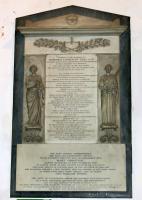

Flaxman's carved monument to Prof. Edward Christian, d.1823.
- The Revd. William Jones, d.1821, identical to the Mary Lutyens panel noted above.
- Easter Jones, d.1823, of Hoddesdon, As a feeble record of her benevolence and
truly Christrian Charity, This Tablet is Erected in affectionate respect by a A Grateful Friend.
Well, a bit feeble the panel is cut with little feet, under which are balls, and there is the thin line border
seen on the Hillock monument. The shelf above has moulding underneath, and there is the usual black backing panel.
Certainly not ostentatious.
- Theodosia Jones, d.1827, wife of the Revd. William Jones noted above. To the same design
as the Mary Lutyens panel noted above.
- Jacob Bosanquet, d.1828, tall Gothic arched panel underneath a row of fretwork-like ornament, with quatrefoils
in the spandrels, skinny pilasters to the side. At the base, a little shield of arms in a quatrefoil, and flowery supports to the pilasters.
On a thin black backing. It was made by the stonemason T. Marsh of New Road, London, who is represented by several panels with
minor carving in London churches.
Henry Westmacott panel to Henrietta Williams. 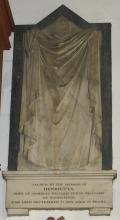
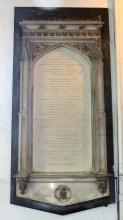 T. Marsh of London panel to Jacob Bosanquet.
T. Marsh of London panel to Jacob Bosanquet.
- Colonel Samuel Wood, d.1830, of the East India Company and Order of the Bath, and his wife
Ann Wood, d.1850. White panel with thin upper and lower shelf. Above, a broad pot in high relief
with nicely looped handles, and below, a large coat of arms, well carved. On a black shaped backing.
- Mrs Mary Elizabeth Whittingstall, d.1831, casket tomb end with outward sloping sides, upper shelf,
and resting on ball feet, on a pentagonal black backing.
- William Peere Williams Freeman, d.1832, Admiral of the Fleet. Tall blocky panel with carved shield
of arms over the inscription, rounded pediment above with swirly low relief patterns and nice acroteria,
and repeating bands of decoration below, and at the base of the monument, a great blocky shelf with
two rounded supports bearing low relief semi-flowers. On a black backing which does not go down as far as
the bottoms of the supports.
- John Christie, d.1831, slightly out of our chronological order, to put the Christie panels together.
A panel cut with small feet, and with a heavy pediment above bearing central shield of arms and flanked
by low relief scrolling; above are nicely carved acroteria, central and to the sides. On a shaped black backing.
Joseph Theakston of Pimlico, London, was the sculptor, a significant artist known as one of the chief assistants
of Sir Francis Chantrey, and a fairly prolific worker in his own right, with some fair pieces to his name.
- Georgina Eliza Christie, d.1832. Chunky panel with upper pediment, no entablature, and upon it,
a wreath of flowers, decently carved. On a black backing panel signed by the sculptor-mason,
Theakston of Pimlico again.
- John Lawrence Christie, d.1836, a plain oval on a dark backing with a shelf above.
By the looks of it there was once a full frame, and perhaps more.
- John Loudon McAdam, d.1836, and his second wife, Anne Charlotte McAdam, d.1852.
The epitaph describes him as the great improver of the British Roads, who resided some years at Hoddesdon
in this Parish . He was famous enough that I for one learned about him at school
the originator of the macadam road, made of small pieces of broken rock, that would shed water
and protect the earth underneath the much later use of tar on such roads gave rise to tarmac .
Back to our art and craftsmanship though, this is a simple little panel, a casket-end,
with little feet at the bottom, outward sloping sides, and a pediment-like lid above a moulded shelf,
with acroteria, all on a black, shaped backing panel. A picture is further up this page.
- Thomas Wallis, d.1836, plain white pane with nipped corners on a black backing.
- The Revd. Francis Thackeray, d.1842, Curate of the Parish, and one of the numerous grandsons
of the late Revd. Thomas Thackeray, Archdeacon of Surrey . Panel with upper shelf bearing a repeating pattern,
and on top, a small pot with enough drapery to flow over the whole top of the panel and half way down the sides.
- Rear Admiral D.H. O Brien RN, d.1857, and his wife Hannah (Walmsley) O Brient, d.1863.
He was of local importance, but his commemorative panel is simple enough: cut with feet, a moulded shelf,
and on a black panel on small supports.
- Godfrey Raymond Bosanquet, d.1858, a young child. Classical panel on a white backing,
with side pilasters, upper and lower shelf, both decorated with repeating patterning, and cut to pediment shape
above with a winged cherub head upon this, the wings covering most of the surface, which would not be the done thing
before Victorian times. See picture below.
- Charles Tuckness, d.1883, and his wife Charlotte, d.1892, of Demerara, British Guiana.
As a tomb chest end, with feet, upper shelf and lid, on a shaped black panel.
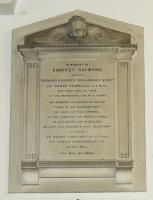 Godfrey Bosanquet, d.1858, with cherub head.
Godfrey Bosanquet, d.1858, with cherub head.
Monuments of the 20th Century, and note on brasses:
- Arthur Grantham Faithfull Chittenden, d.1904. Pinky-brown alabaster frame, with an inner mosaic
frame of gilt and blue mosaic, finely crafted with leaflets, and crosses fleury at the corners;
a cross of mother of pearl is above the inscription, which is in a fine Arts and Crafts text.
- Charles Grant Thomas Faithfull Chittenden, d.1905. The companion piece to Arthur Chittenden above,
and even better. A beautiful Arts and Crafts panel, with a pinkish alabaster frame within which is a design of blue
and red and mother-of-pearl mosaic, with a central cross at the top, and down each side, a flowering vine
with gold mosaic stem and mother of pearl leaves. Exquisite.
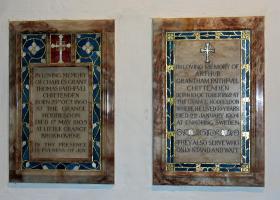 Mosaic ornament on the Chittenden panels, 1900s Arts and Crafts.
Mosaic ornament on the Chittenden panels, 1900s Arts and Crafts.
- Cecil Edward Hamilton Hoskins, d.1912, who died in consequence of a fall from his horse,
near South Grafton, New South Wales in Australia. Plain panel with bevelled edges, an example of the plainness
which came to dominate monumental panels later on.
- Lieutenant Arthur Grant Bourne Chittenden, d.1914, killed in action near Soissons, France.
Nice alabaster panel with a mosaic border in dark blue-green and gilt around the central inscribed area.
Characteristic of the time.
- Lieutenant Eustace Alfred Morey Nichols, d.1916, killed in action near Hardecourt, France.
Rectangular panel with the regimental insignia carved in relief, on a black backing panel.
- Lieut. Paul Norman Jones Christie, d.1917, plain panel on a black backing,
with a tiny regimental coat of arms.
- Captain Arthur Fowler Newsam, d.1918, of the Imperial Camel Corps, who was killed at Amman
in the Mountains of Moab, and his father, John Fowler, d.1918. A late Arts and Crafts panel, of beige alabaster
with a line of gilt mosaic as an inner border, then a string course of red and white alabaster,
and then an outer frame of green banded serpentine, much beloved material of the 1900s masons.
- Lieutenant Christopher Brandram, d.1918, Queen Victoria s Rifles, brass panel with
inscribed line border, and regimental sigils.
- John Salwey, d.1919, Vicar of the Parish. A grey stone panel, with a painted shield in the corner,
and decorated by a thick border, carved in low relief with curling branches and Tudor Roseish flowers at the corners.
There are also several modern brasses in the Church, and we may note that to Elizabeth Stanford Searle, d.1895,
with its border of little flowers and leaves, as exemplary of the more ornamental sort.
Also that to Captain Walinsley? Donat O Brien, d.1900, who died in the Boer War, South Africa.
This is an example of an Arts and Crafts brass, with excellent embossed text and decorative side elements.
Also in the Church:
Outside the Church:
The churchyard is extensive, and includes examples of many of the familiar types of churchyard memorial,
including an interesting hexagonal tomb chest, various other tomb chests with thickly carved decoration,
including a Bosanquet one from the 19th Century, and a good variety of crosses with ornamental carving
see this page for more on churchyard monuments, and particularly on crosses. Also another font, with three pillars around a centre,
abandoned under a tree.
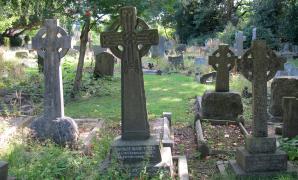
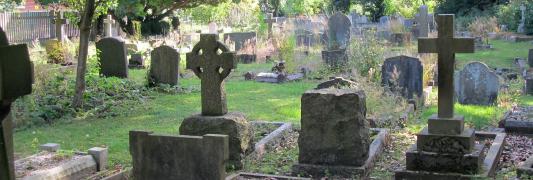
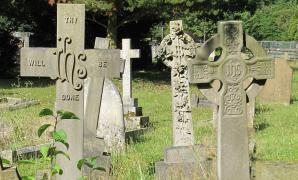
Churchyard, sample celtic and decorated cross monuments.
A little way off from the front of the Church, on the common, is the main Broxbourne World War I memorial,
a cross raised on a tall shaft, on several steps, and surrounded by railings. It bears relief carving of a sword
with a wreath over it, and a winged ornament with another wreath.
With many thanks to The Revd Charles Hudson for kind permission to use pictures from inside the Church;
see the Church website at http://www.staugustinesbroxbourne.org.uk.
 Broxbourne War Memorial.
Broxbourne War Memorial.
Top of page
Also in Hertfordshire: monuments in other Hertfordshire churches, including Tring Church, Wheathampstead Church, Aldenham Church and Abbots Langley Church
Cheslyn Gardens statue, Watford
Introduction to church monuments // Angel statues // Cherub sculpture
Sculpture in some towns in England
Home
Visits to this page from 19 Nov 2016: 6,165
















 Mid-17th Century Classical tablets - black panels, side pilasters, curved pediments.
Mid-17th Century Classical tablets - black panels, side pilasters, curved pediments.

 White on black panels of the 1790s: Judge Jones and Henrietta Bosqanquet.
White on black panels of the 1790s: Judge Jones and Henrietta Bosqanquet.








 T. Marsh of London panel to Jacob Bosanquet.
T. Marsh of London panel to Jacob Bosanquet.
 Godfrey Bosanquet, d.1858, with cherub head.
Godfrey Bosanquet, d.1858, with cherub head.
 Mosaic ornament on the Chittenden panels, 1900s Arts and Crafts.
Mosaic ornament on the Chittenden panels, 1900s Arts and Crafts.


